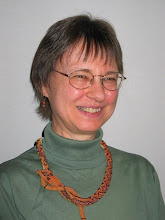We finally found St. Michael's Church. This splendid, baroque church was completed in 1786 but destroyed by fire in 1906. Luckily, the Senate immediately decided to rebuild the church on the same site from the original plans. We neglected to climb the 452 steps of the tower for a view of the city but enjoyed the view of the interior.
 |
| The tower at St. Michael's Church |
 |
| Part of the interior The organ or at least part of it After that, we wandered over the bridges and past the 19-century, brick warehouses in the Speicherstadt (warehouse district ), the largest warehouse district in the world. Many of the buildings have now been turned into housing. Hamburg really is a city of water One of the many bridges to the warehouse district An example of the beautiful 19-century warehouses This imposing building turned out to be the firehouse. We ate a lunch of sandwiches and iced coffee at a small bakery in the warehouse district and got our first introduction to German Eiskaffee. Here in the U.S., iced coffee is cold coffee poured over ice but that's not the German way. There Eiskaffee is a glass of half coffee and half whipped cream. One version we had even added a scoop of vanilla ice cream! I borrowed this photo of Eiskaffee from a recipe because I was in such awe that I forgot to take a photo of our glasses. After lunch, Don continued his sightseeing with a visit to the Internationales Maritimes Museum, where he toured model ships, oil paintings, uniforms, and figureheads. Model ship from the Internationales Maritimes Museum I, however, headed back to the venue because the shopping at Beaders Best opened at 4 pm. I HAD to be there because I was meeting a student....really....I did. Okay, I looked around after my meeting. One of the beads that caught my eye on the Perlen Poesie website was a lovely lampwork bead by Barbara Wiemers. Not only did I get to buy one of her lovely beads, but I got to meet Barbara herself. Hydrangea bead by Barbara Wiemers Here are Barbara and I holding some of her glass beads. To see more of Barbara's beads, visit Weserperlen. My one other purchase was more lampwork beads from Christiane Imkamp of Smauggs. I now think I should have bought more but she does have an Etsy shop. One ring with a froggie and 2 mushrooms to make earrings-I really was good. Here are a few more shots of the shopping taken by Freddie Ott, the creative director of Perlen Poesie. I was too busy to take photos (I know, I know-I have to remember to take photos). Shopping (photo by Freddie Ott) |
 |
| Some of the artisans (photo by Freddie Ott) |
 |
| More shopping (photo by Freddie Ott) |
 |
| More (photo by Freddie Ott) |


















































